General Sir John Monash, Personal Files Book 17, 11 February - 18 March 1918, Part 9


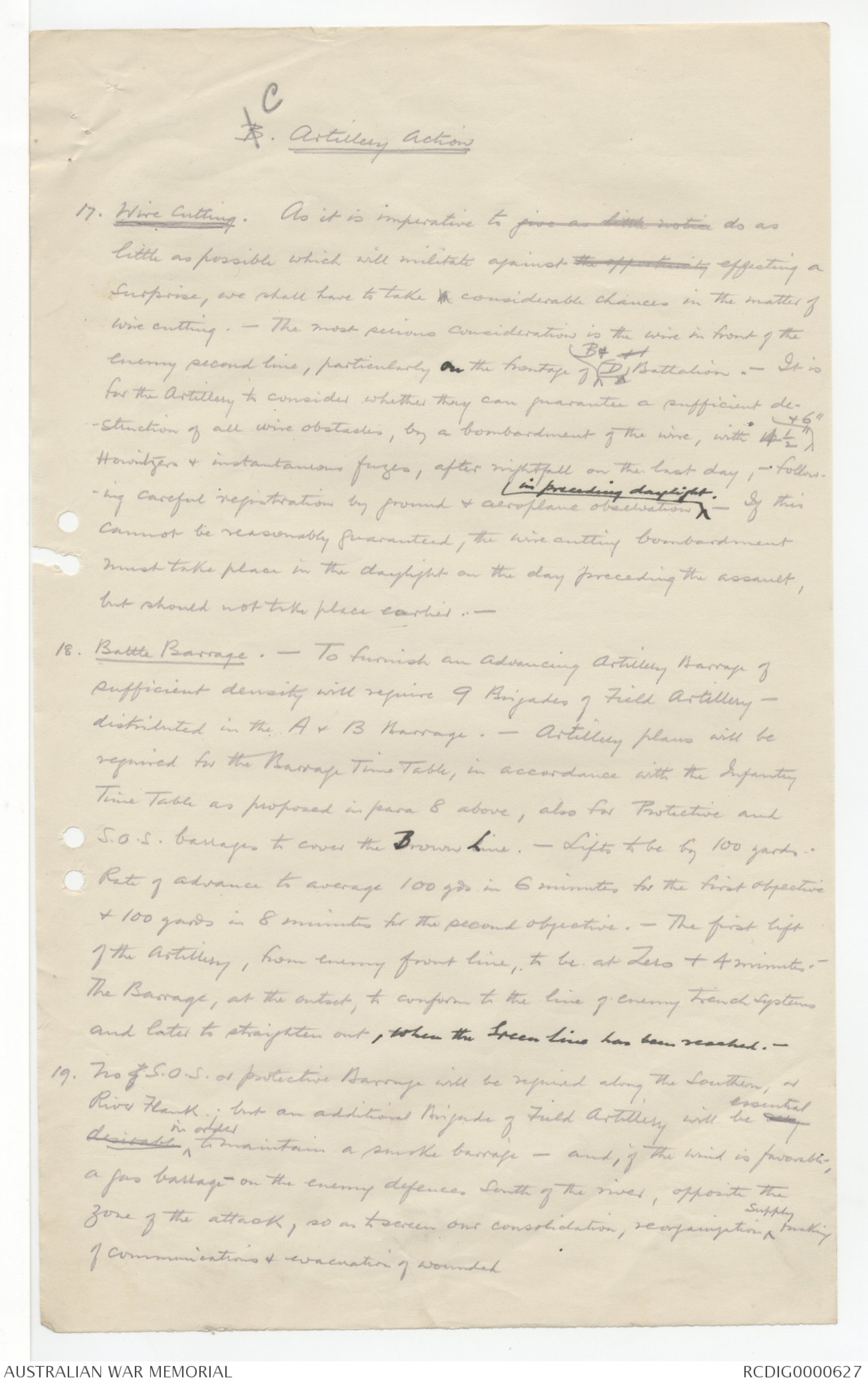
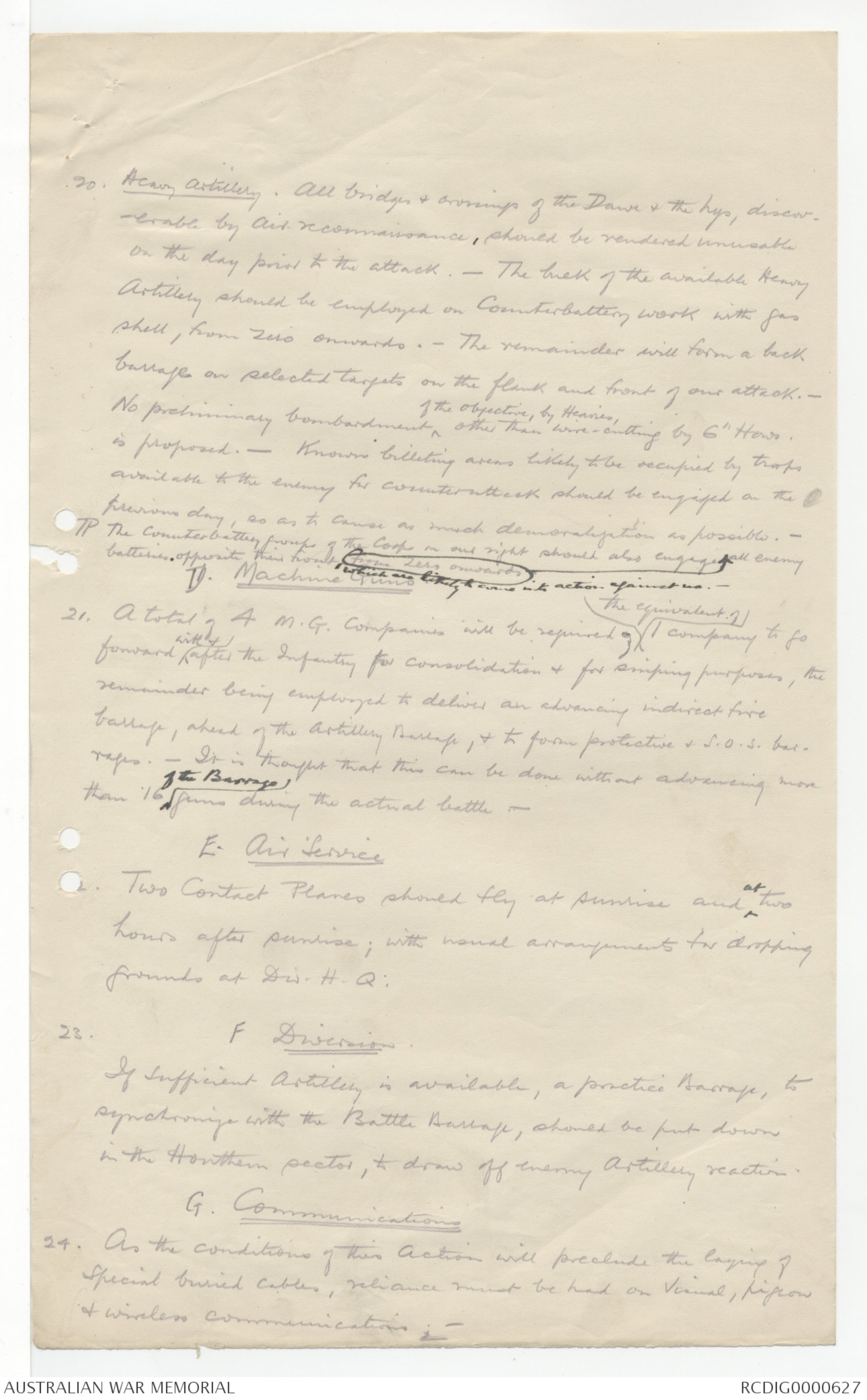
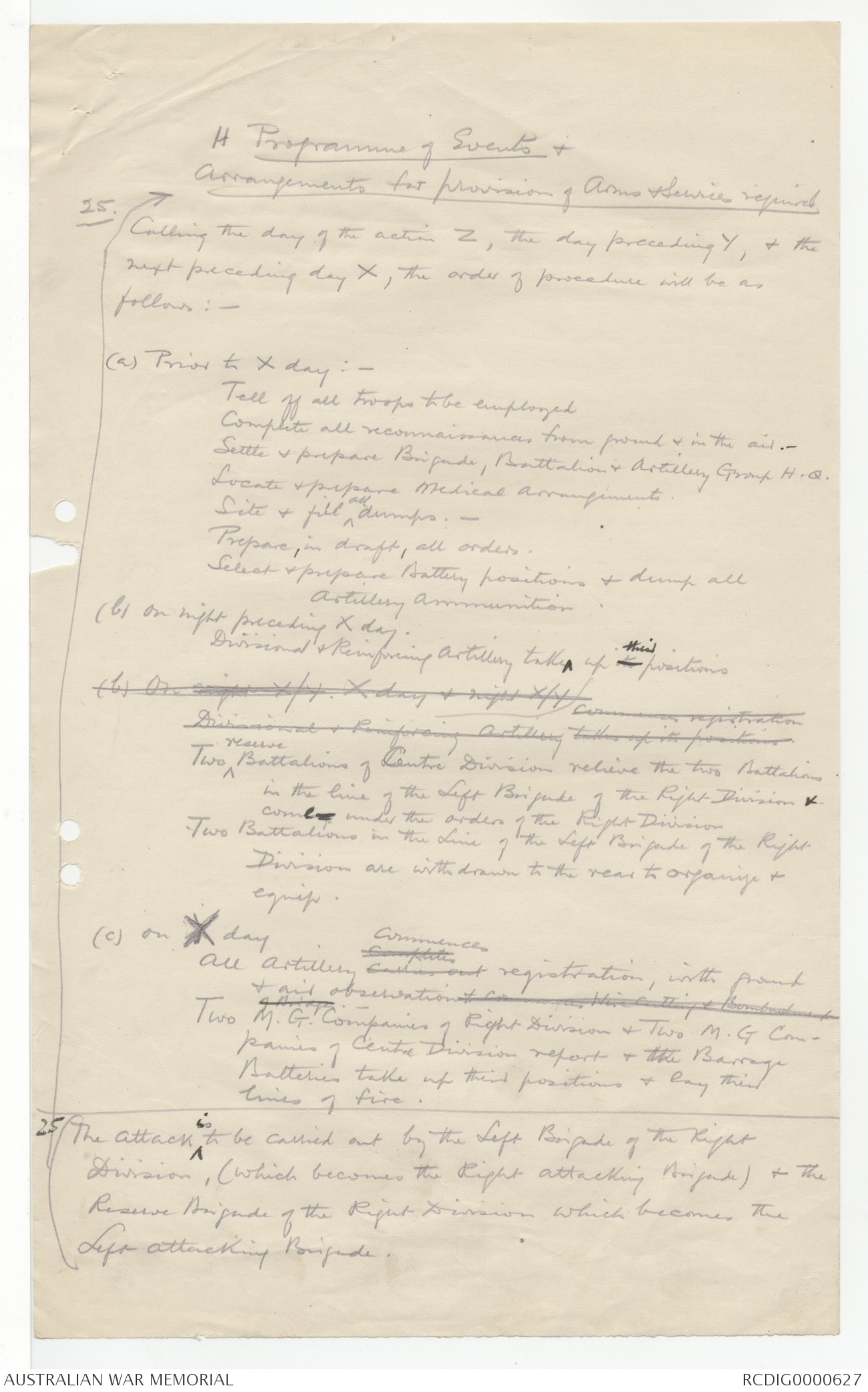
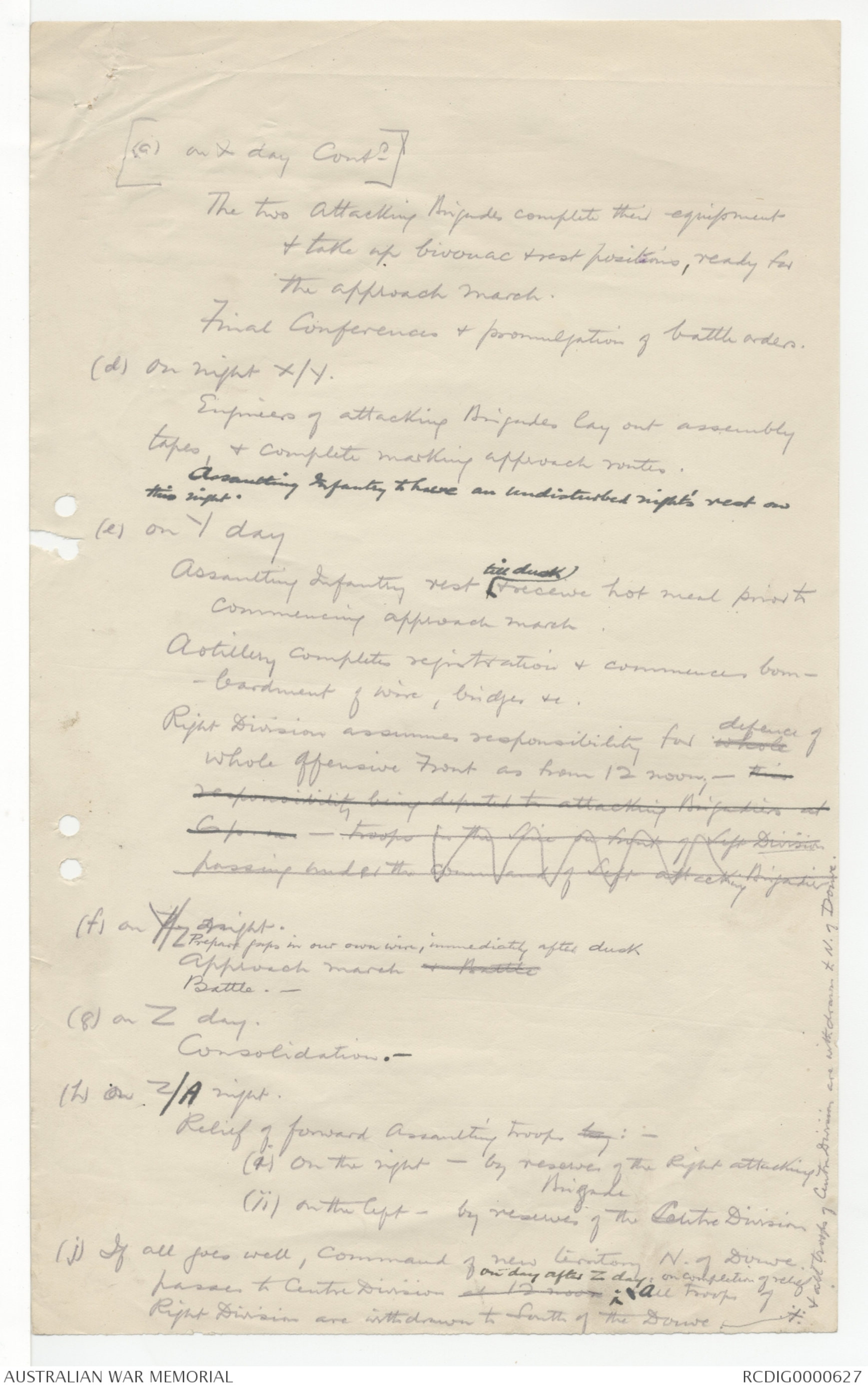
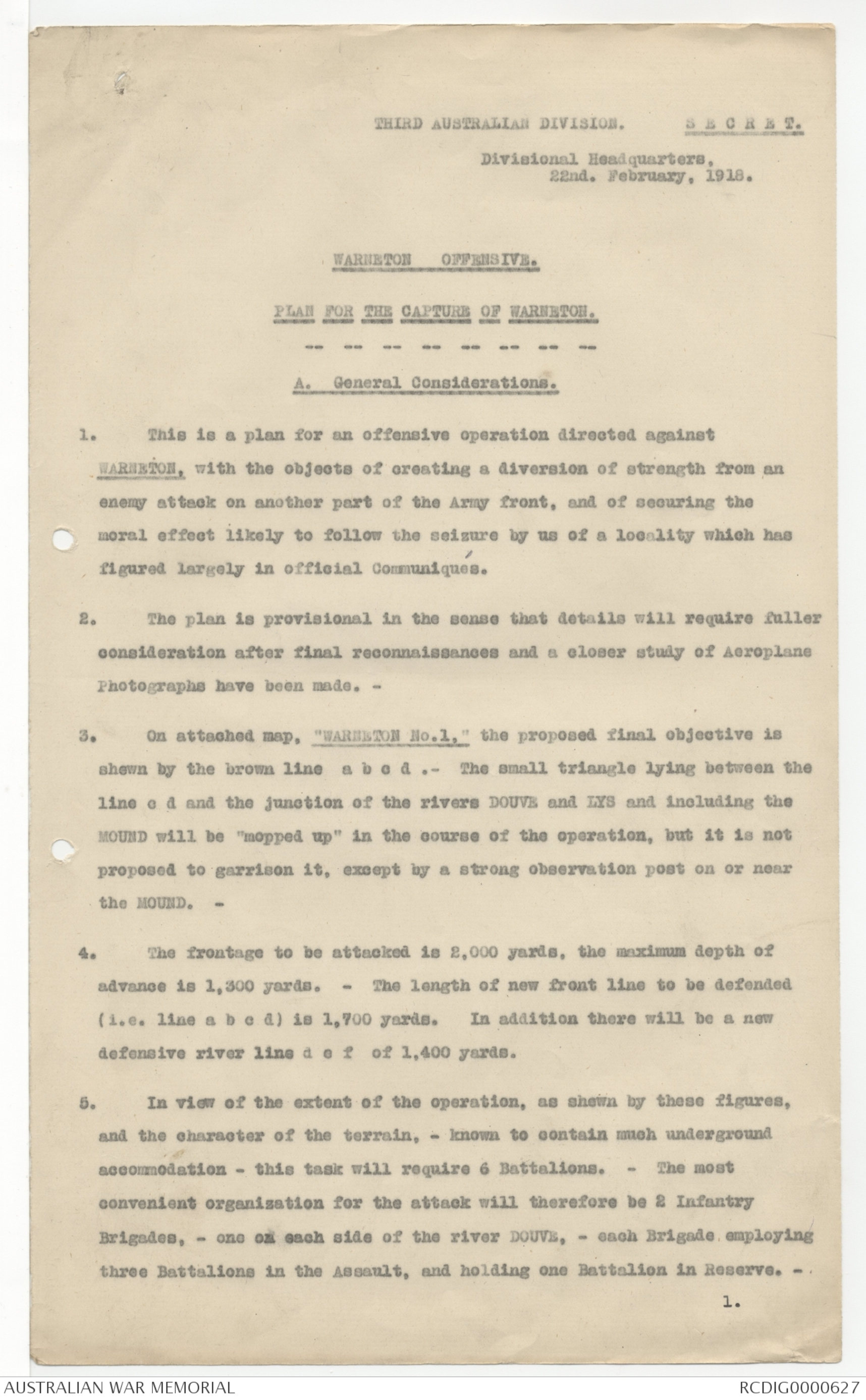
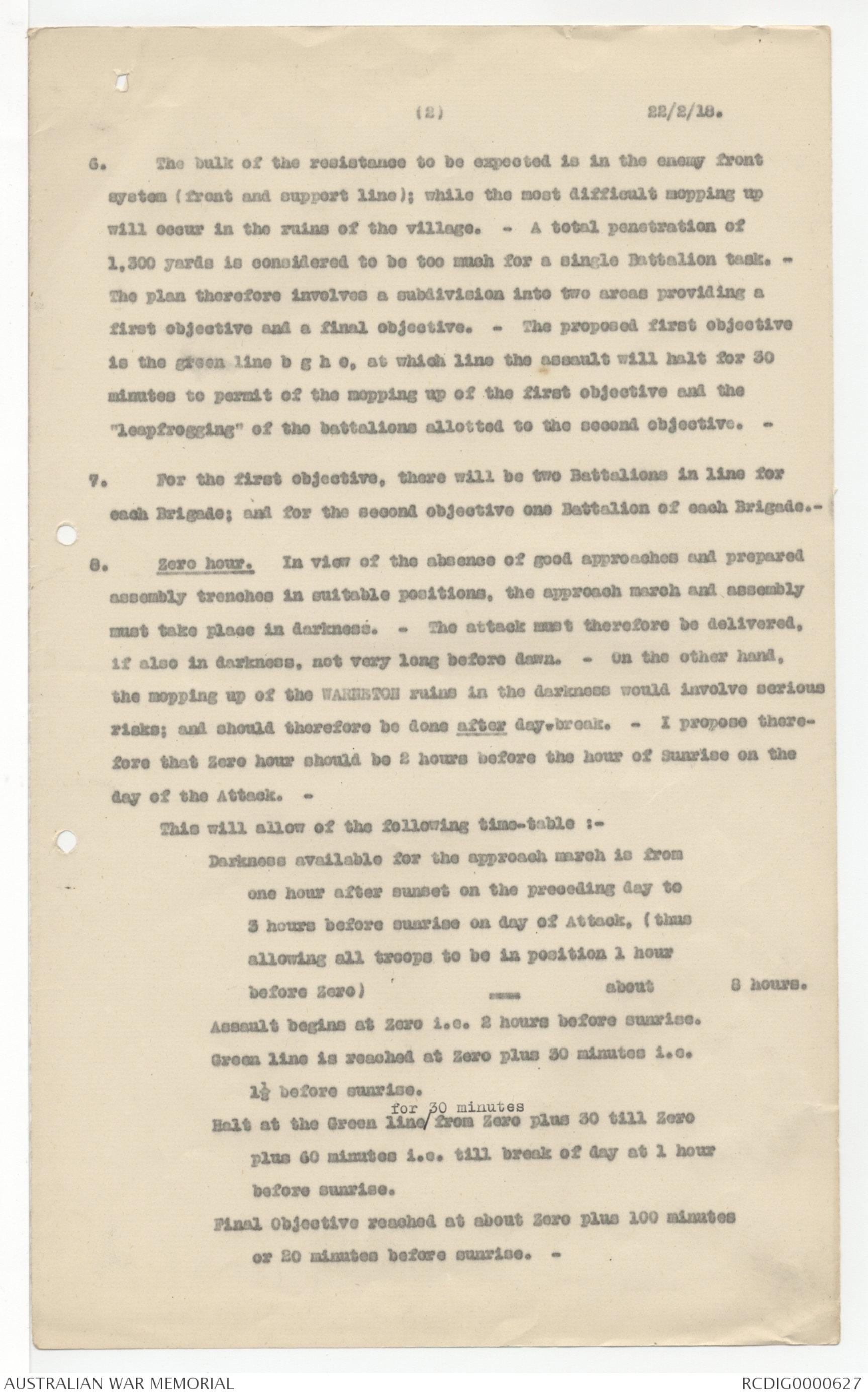
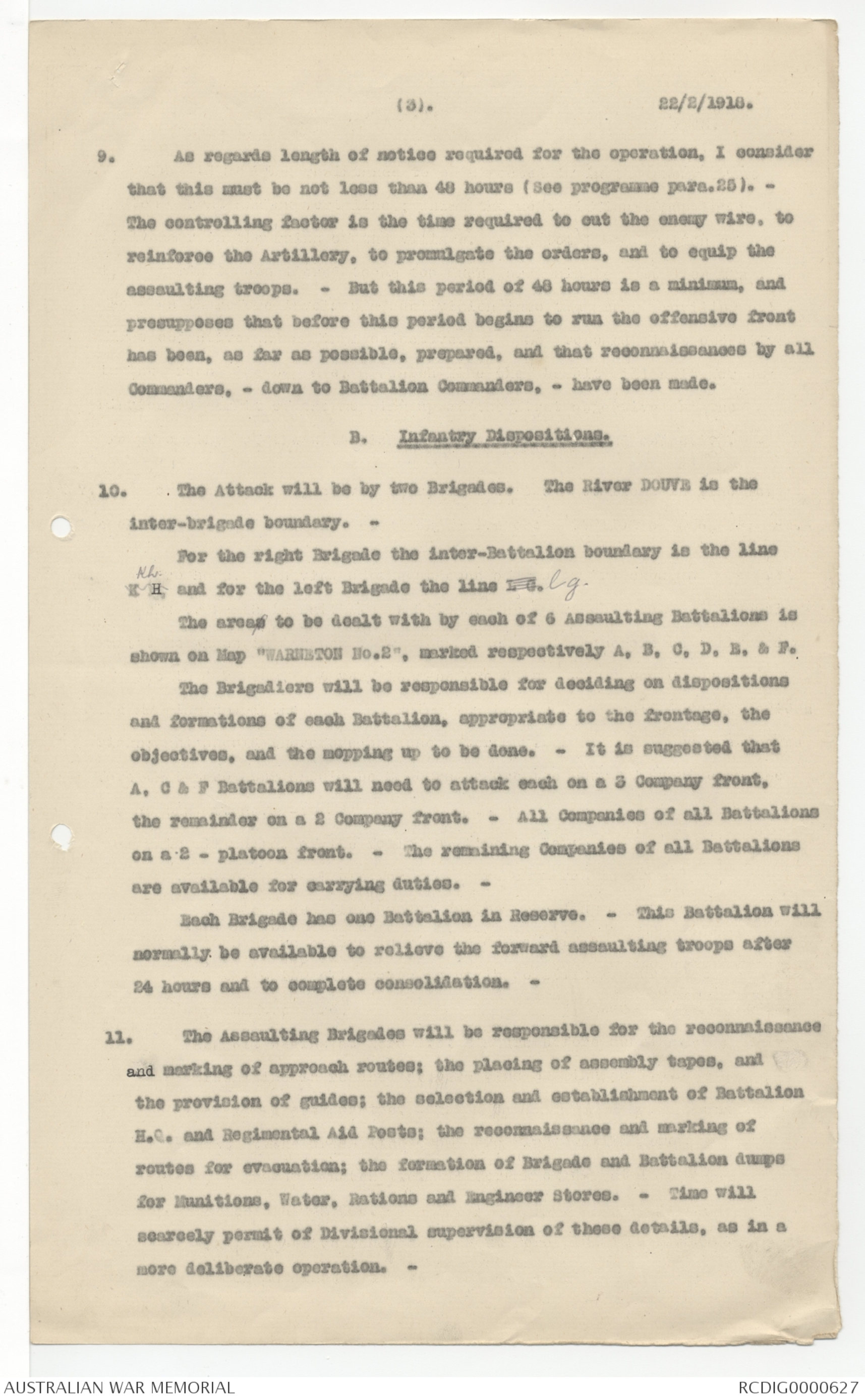

B Infantry Actions
9. As regards length of notice required for the cooper operation, I consider
that this should ∧must be not less than 48 hours ^see programme para 25.). The controlling factor is
the time required to cut the enemy wire, & to xxxx reinforce the Artillery,
to promulgate the orders, & to equip the assaulting troops. - But this
period of 48 hours is a minimum, & presupposes that ^before this period begins to run the offensive
front has been, as far as possible, prepared beforehand, & that reconnaissances
by all commanders, - down to Battalion Commanders, - have
been made. beforehand
B. Infantry Dispositions10. While the Brigadiers concerned will decide on their ∧final dispositioning
10. The attack will be by two Brigades. The River Douve is the
inter-brigade boundary. -
For the right Brigade the inter-Battalion boundary is the line Kh, &
for the left Brigade the line of lg.
The areas to be dealt with by each of 6 assaulting Battalions is
shown on Map "Warneton No 2", marked respectively A, B, C, D, E, & F.
The Brigadiers will be responsible for deciding on the dispositions, ∧& formations of each
Battalion, appropriate to the frontage, the objectives, & the mopping up to be
done. - It is suggested that A, C & F Battalions will need to attack on
each on a 3 Company front, the remainder on a 2 Company
front. - All Companies of all Battalions on a 2-platoon front. -
The remaining Companies of all Battalions are available for carrying
duties.-
Each Brigade has 1 ∧one Battalion in Reserve. - This Battalion will
normally be available to relieve the forward assaulting troops after
24 hours & to complete consolidation.-
11. The Assaulting Brigades will be responsible for the reconnaissance
& marking of approach routes; the placing of assembly tapes, and
the provision of guides; the ^selection & establishment of Battalion H.Q, and the
Regimental Aid Posts; the reconnaissance & marking of routes for
evacuation; the xxxx ^formation of Brigade & Battalion dumps for Munitions,
Water, Rations & Engineer stores. - Time will scarcely permit of
Divisional supervision of these details, as in a more deliberate11 operation. -
11. (a) The Infantry will also be responsible for digging communications
across No Man's Land, immediately after the assault; two on each
Brigade front; - locations to be selected after further reconnaissances .
12. The Infantry will be responsible for consolidation of the ground won
and for organising its defence in depth. - For this par To assist
in this each assaulting Brigade will have allotted to it 8 Machine guns
& the whole of its L.T.M. Battery.
13. The lines of assembly for the left Brigade will need to be carefully
chosen, owing to the proximity of xx the respective front lines; & ^to the obliquity
of the direction of the advance to our present front.- B
14. Both Brigades must make arrangements to form ^as the advance proceeds a defence to their
outer flanks, particularly on the left flank
of the left Brigade, which is the most probable direction from which a
flank counterattack will come. – The defence of the right flank of
the right Brigade will be met by a few posts placed to deny the use
of the river Lys to the enemy. -
15. The B Battalion will, on completion of its task, have no frontage or flank
to defend, & is therefore available to provide lateral communication over the
Douve into the territory of D Battalion, & also to assist A Battalion in
mopping up its area.
16. As part of the Consolidation of the new area, a line of ^strong posts should
be established & dug in & wired, generally along the ^green line b h e, as aline rear line of resistance, & as a support to the brown line
B C. Artillery Action
17. Wire Cutting As it is imperative to give as little notice do as
little as possible which will militate against the opportunity effecting a
surprise, we shall have to take a considerable chances in the matter of
wire cutting. - The most serious consideration is the wire in front of the
enemy second line, particularly on the frontage of ^B & D Battalion. - It is
for the Artillery to consider whether they can guarantee a sufficient destruction
of all wire obstacles, by a bombardment of the wire, with 4½" ^& 6"
Howitzers & instantaneous fuzes, after nightfall on the last day, - following
careful registrations by ground & aeroplane observations ^in preceding daylight. - If this
cannot be reasonably guaranteed, the wire cutting bombardment
must take place in the daylight on the day preceding the assault,
but should not take place earlier. -
18. Battle Barrage. To furnish an Advancing Artillery Barrage of
sufficient density will require 9 Brigades of Field Artillery -
distributed in the A & B Barrage. - Artillery plans will be
required for the Barrage Time Table, in accordance with the Infantry
Time Table as proposed in para 8 above, also for Protective and
S.O.S. barrages to cover the Brown Line. - Lifts to be by 100 yards.
Rate of advance to average 100 yds in 6 minutes for the first objective
& 100 yards in 8 minutes for the second objective. - The first lift
of the Artillery, from enemy front line, to be at Zero + 4 minutes. -
The Barrage, at the outset, to conform to the line of enemy Trench Systems
and later to straighten out, when the Green line has been reached.-
19. No 1 S.O.S. or protective Barrage will be required along the Southern, or
River Flank; but an additional Brigade of Field Artillery will be ^essential saydesirable ^in order to maintain a smoke barrage - and, if the wind is favourable,
a gas barrage - on the enemy defences South of the river, opposite the
zone of the attack, so as to screen our consolidation, reorganisation ^supply making
of communications & evacuation of wounded
20. Heavy Artillery. All bridges & crossings of the Douve & the Lys, discoverable
by Air reconnaissance, should be rendered unusable
on the day prior to the attack. - The bulk of the available Heavy
Artillery should be employed on Counterbattery work with gas
shell, from zero onwards. - The remainder will form a back
barrage on selected targets on the flank and front of our attack. -
No preliminary bombardment ^of the objective, by Heavies, other than wire-cutting by 6" Hows.
is proposed. - Known billeting areas likely to be occupied by troops
available to the enemy for counterattack should be engaged on the
previous day, so as to cause as much demoralisation as possible. -
TP The Counterbattery groups of the Corps on our right should also engage ^from zero onwards all enemy
batteries opposite their front, which are likely to come into action against us. -
D. Machine Guns
21. A total of 4 M. G. Companies will be required; ^the equivalent of 1 company to go
forward ^with & after the Infantry for consolidation & for sniping purposes, the
remainder being employed to deliver an advancing indirect fire
barrage, ahead of the Artillery Barrage, & to form protective & S.O.S. barrages. -
It is thought that this can be done without advancing more
than 16 ^of the Barrage guns during the actual battle -
E. Air Service.
22. Two Contact Planes should fly at sunrise and ^at two
hours after sunrise; with usual arrangements for dropping
grounds at Div. H.Q.
23. F Diversion
If sufficient Artillery is available, a practice Barrage, to
synchronize with the Battle Barrage, should be put down
in the Houthern sector, to draw off enemy Artillery reaction.
G. Communications
24. As the conditions of this Action will preclude the laying of
Special buried cables, reliance must be had on Visual, pigeon
& wireless communications; -
H Programme of Events &
Arrangements for provision of Arms & Services required
25. ^The attack ^is to be carried out by the Left Brigade of the Right
Division, (which becomes the Right attacking Brigade) & the
Reserve Brigade of the Right Division which becomes the
Left attacking Brigade.
Calling the day of the action Z, the day proceeding Y, & the
next preceding day X, the order of procedure will be as
follows: -
(a) Prior to X day:-
Tell off all troops to be employed
Complete all reconnaissances from ground & in the air. -
Settle & prepare Brigade, Battalion & Artillery Group H.Q.
Locate & prepare Medical Arrangements.
Site & fill ^all dumps. -
Prepare, in draft, all orders.
Select & prepare Battery positions & dump all
Artillery Ammunition
(b) On night preceding X day.
Divisional & Reinforcing Artillery take up its ^their positions(b) On night X/Y X day & night X/Y commence registrationDivisional & Reinforcing Artillery take up its positions.
Two ^reserve Battalions of Centre Division relieve the two Battalions
in the line of the Left Brigade of the Right Division &
come under the orders of the Right Division
Two Battalions in the Line of the Left Brigade of the Right
Division are withdrawn to the rear to organize &
equip.
(c) on X day
All Artillery carries out completes ^commences registration, with ground
& air observation to commence wire cutting & bombardment of Bridge:-
Two M. G Companies of Right Division & Two M. G Companies
of Centre Division report & the Barrage
Batteries take up their positions & lay their
lines of fire.
[ (c) on X day contd ]
The two Attacking Brigades complete their equipment
& take up bivouac & rest positions, ready for
the approach march.
Final Conferences & promulgation of battle orders.
(d) on night X/Y.
Engineers of attacking Brigades lay out assembly
tapes, & complete marking approach routes.
Assaulting Infantry to have an undisturbed night's rest on
this night.
(e) on Y day
Assaulting Infantry rest ^till dusk & receive hot meal prior to
commencing approach march.
Artillery complete registration & commences bombardment
of wire, bridges &c.
Right Division assumes responsibility for whole ^defence of
whole offensive front as from 12 noon - thisresponsibility being deputed to attacking Brigadiers atxxx troops in the line on front of Left Divisionpassing under the Command of Left attacking Brigadiers
(f) on Y/Z night.
Prepare gaps in our own wire, immediately after dusk
Approach march & Battle
Battle. -
(g) on Z day.
Consolidation. -
(h) on Z/A night
Relief of forward assaulting troops by : -
(i) on the right - by reserve of the Right attacking
Brigade
(ii) on the left- by reserve of the Centre Division
(j) If all goes well, command of new territory N. of Douve.
passes to Centre Division at 12 noon ∧ on day after Z day on completion of relief. All troops of
Right Division are withdrawn to South of Douve
[*※ & all troops of Centre Division are withdrawn to N. of Douve.*]
THIRD AUSTRALIAN DIVISION. SECRET
Divisional Headquarters,
22nd. February, 1918.
WARNETON OFFENSIVE.
PLAN FOR THE CAPTURE OF WARNETON
A. General Considerations.
1. This is the plan for an offensive operation directed against
WARNETON, with the objects of creating a diversion of strength from an
enemy attack on another part of the Army front, and of securing the
moral effect likely to follow the seizure by us of a locality which has
figured largely in official Communiques.
2. The plan is provisional in the sense that details will require fuller
consideration after final reconnaissances and a closer study of Aeroplane
Photographs have been made. -
3. On attached map, “Warneton No.1. the proposed final objective is
shewn by the brown line a b c d .- The small triangle lying between the
line c d and the junction of the rivers DOUVE and LYS and including the
MOUND will be "mopped up" in the course of the operation, but it is not
proposed to garrison it, except by a strong observation post on or near
the MOUND. -
4. The frontage to be attacked is 2,000 yards, the maximum depth of
advance is 1,300 yards. - The length of new front line to be defended
(i.e. line a b c d) is 1,700 yards. In addition there will be a new
defensive river line d e f of 1,400 yards.
5. In view of the extent of the operation, as shown by these figures,
and the character of the terrain, - known to contain much underground
accommodation - this task will require 6 Battalions. - The most
convenient organization for the attack will therefore be 2 Infantry
Brigades, - one on each side of the river DOUVE, - each Brigade employing
three Battalions in the Assault, and holding one Battalion in Reserve. -
1.
(2) 22/2/18.
6. The bulk of the resistance to be expected is in the enemy front
system (front and support line); while the most difficult mopping up
will occur in the ruins of the village. - A total penetration of
1,300 yards is considered to be too much for a single Battalion task. -
The plan therefore involves a subdivision into two areas providing a
first objective and a final objective. - The proposed first objective
to the green line b g h e, at which line the assault will halt for 30
minutes to permit of the mopping up of the first objective and the
"leapfrogging" of the battalions allotted to the second objective. -
7. For the first objective, there will be two Battalions in line for
each Brigade; and for the second objective one Battalion of each Brigade. -
8. Zero Hour In view of the absence of good approaches and prepared
assembly trenches in suitable positions, the approach march and assembly
must take place in darkness. - The attack must therefore be delivered,
if also in darkness, not very long before dawn. - On the other hand,
the mopping up of the WARNETON ruins in the darkness would involve serious
risks; and should therefore be done after day-break. - I propose therefore
that Zero hour should be 2 hours before the hour of Sunrise on the
day of the Attack. -
This will allow of the following time-table :-
Darkness available for the approach march is from
one hour after sunset on the preceding day to
3 hours before sunrise on day of Attack, (thus
allowing all troops to be in position 1 hour
before Zero) - about 8 hours.
Assault begins at Zero i.e. 2 hours before sunrise.
Green line is reached at Zero plus 30 minutes i.e.
1½ before sunrise.
Halt at the Green line ∧ for 30 minutes from Zero plus 30 till Zero
plus 60 minutes i.e. till break of day at 1 hour
before sunrise.
Final objective reached at about Zero plus 100 minutes
or 20 minutes before sunrise. -
(3). 22/2/1918.
9. As regards length of notice required for the operation, I consider
that this must be not less than 48 hours (See programme para.25). -
The controlling factor is the time required to cut the enemy wire, to
reinforce the Artillery, to promulgate the orders, and to equip the
assaulting troops. - But this period of 48 hours is a minimum, and
presupposes that before this period begins to run the offensive front
has been, as far as possible, prepared, and that reconnaissances by all
Commanders, - down to Battalion Commanders, - have been made.
B. Infantry Dispositions
10. The Attack will be by two Brigades. The River DOUVE is the
inter-brigade boundary. -
For the right Brigade the inter-Battalion boundary is the lineKH ∧ Kh and for the left Brigade the line L G. l g.
The areas to be dealt with by each of 6 Assaulting Battalions is
shown on Map "WARNETON No. 2", marked respectively A, B, C, D. E. & F.
The Brigadiers will be responsible for deciding on dispositions
and formations of each Battalion, appropriate to the frontage, the
objectives, and the mopping up to be done. - It is suggested that
A, C & F Battalions will need to attack such as a 3 Company front,
the remainder on a 2 Company front. - All Companies of all Battalions
on a 2 - platoon front. - The remaining Companies of all Battalions
are available for carrying duties. -
Each Brigade has one Battalion in Reserve. - This Battalion will
normally be available to relieve the forward assaulting troops after
24 hours and to complete consolidation. -
11. The Assaulting Brigades will be responsible for the reconnaissance
and marking of approach routes; the placing of assembly tapes, and
the provision of guides; the selection and establishment of Battalion
H.Q. and Regimental Aid Posts; the reconnaissance and marking of
routes for evacuation; the formation of Brigade and Battalion dumps
for Munitions, Water, Rations and Engineer Stores; - Time will
scarcely permit of Divisional supervision of these details, as in a
more deliberate operation. -
(4) 22/2/18.
11.(a). The Infantry will be responsible for digging communications
across NO MAN'S LAND, immediately after the assault; two on each
Brigade front; - locations to be selected after further reconnaissance. -
12. The Infantry will be responsible for consolidation of the ground
won and for organizing its defence in depth. - To assist in this
each Assaulting Brigade will have allotted to it 8 Machine Guns and the
whole of its L. T. M. Battery.
13. The lines of assembly for the left Brigade will need to be carefully
chosen, owing to the proximity of the respective front lines, and to the
obliquity of the direction of the advance to our present front. -
14. Both Brigades must make arrangements to form as the advance proceeds
a defence to their outer flanks, particularly on the left flank of the
left Brigade, which is the most probable direction from which a flank
counterattack will come. - The defence of the right flank of the right
Brigade will be met by a few posts placed to deny the use of the river
LYS to the enemy.-
15. The B Battalion will, on completion of its task, have no frontage
or flank to defend, and is therefore available to provide lateral
communication over the DOUVE into the territory of D Battalion, and also
to assist A Battalion in mopping up its area.
16. As part of the consolidation of the new area, a line of strong
posts should be established, dug in and wired, generally along the Green
line b h e, as a rear line of resistance, and as a support to the brown
line.
C. Artillery Action
17. Wire Cutting. As it is imperative to do as little as possible which
will militate against effecting a surprise, we shall have to take
considerable chances in the matter of wire cutting. - The most
serious consideration is the wire in front of the enemy second line,
particularly on the frontage of B and D Battalion. - It is for the
Artillery to consider whether they can guarantee a sufficient destruction
of all wire obstacles, by a bombardment of the wire, with
 Sam scott
Sam scottThis transcription item is now locked to you for editing. To release the lock either Save your changes or Cancel.
This lock will be automatically released after 60 minutes of inactivity.